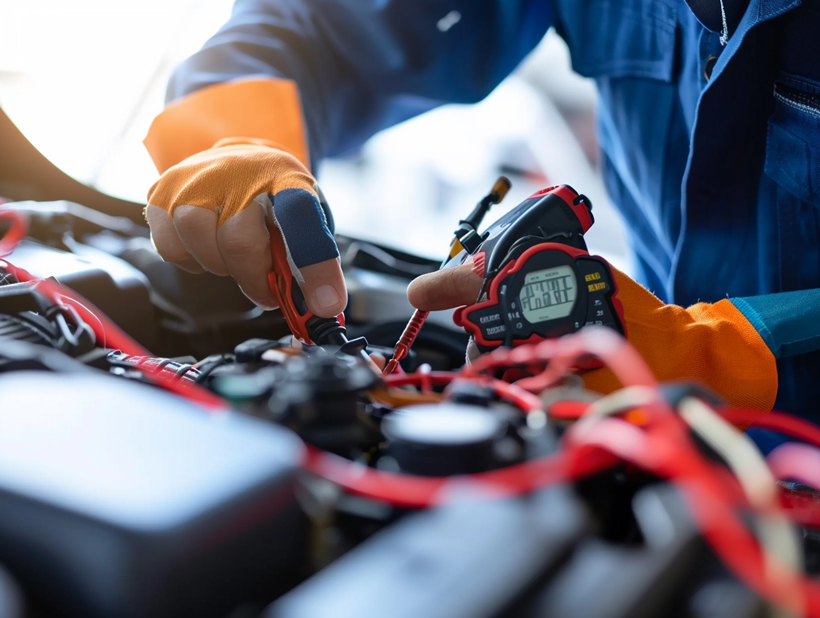Experiencing a dead battery can throw off our entire day. It’s a common issue that leaves us scratching our heads, wondering why our vehicle’s battery dies overnight. We’ve all been there, and it’s not just frustrating‚Äîit’s baffling.
But what if we told you that a parasitic drain might be the culprit? It’s not as sinister as it sounds, but it’s definitely something we need to address. We’re here to guide you through finding and fixing these sneaky electrical issues that can drain your battery dry.
What Causes a Battery to Die Overnight?
Batteries are the unsung heroes of our vehicles, quietly powering up essential components even when the ignition is off. But sometimes, we wake up to find our reliable source of power has died unexpectedly. Here’s what could be behind this mystery:
- Parasitic Drain: As we’ve mentioned, this is a common culprit. It’s the electrical power that certain components use even after you’ve turned off your engine. Ideally, the draw is minimal, but faulty systems or devices can draw more power than they should.
- Old Battery: Batteries have a finite life span. Over time, they lose their ability to hold a charge. If your battery’s older, it may not survive the natural electrical drain that occurs overnight.
- Extreme Temperatures: Both scorching heat and freezing cold can wreak havoc on a battery’s chemistry, accelerating its demise.
- Faulty Alternator: If your alternator isn’t charging your battery sufficiently during drives, it won‚Äôt be at full power by the time you park.

Recognizing the Signs of a Failing Battery
Before a battery gives up entirely, it usually shows some warning signs. Here’s what to look out for:
- Dimming headlights
- Slower engine cranking
- Frequent need for jumpstarts
Preventive Measures
Taking proactive steps can help minimize the risk of waking up to a dead battery:
- Regular Maintenance: Regular checkups for your electrical system can prevent unexpected failures.
- Battery Testing: Periodic testing can reveal a battery’s declining health before it’s too late.
| Action | Benefit |
|---|---|
| Check for loose connections | Prevents power inefficiencies |
| Keep battery terminals clean | Ensures maximum conductivity |
| Replace battery every 3-5 years | Reduces risk of sudden battery failures |
It’s essential to keep an eye on your vehicle and respond promptly to any signs that something’s amiss. Understanding the various factors that contribute to overnight battery death is the first step in troubleshooting and addressing the issue effectively. By acknowledging the potential causes, we’re better equipped to safeguard our vehicle’s battery health for the long haul.
Understanding Parasitic Drain
When we’re faced with a dead battery, it’s crucial to understand the culprit behind it. Parasitic drain is the silent battery killer that operates behind the scenes. It occurs when electrical devices continue to draw power from the battery even after the ignition is turned off. This isn’t just about leaving the headlights on or a door ajar‚Äîparasitic drain can come from more cunning sources.
Various components can be responsible for this power siphon:
- Audio systems
- Alarm systems
- Onboard computers
- Engine management systems
It’s important to note that a certain amount of parasitic drain is normal; our vehicles rely on it to maintain settings such as the time and radio presets. However, when the draw exceeds the normal range, that’s when issues arise.

To identify whether our vehicle suffers from an excessive parasitic drain, we’ll need to measure the electrical current leaving the battery. Using a multimeter set to measure amperage, we can detect the amount of current being used.
For most vehicles, a normal parasitic drain shouldn’t exceed 50 milliamps. Here’s a simple breakdown of what we might see:
| Condition | Current |
|---|---|
| Normal | < 50 mA |
| Concerning | 50-85 mA |
| Problematic | > 85 mA |
If we discover a drain larger than what’s typical, it’s time to pinpoint the exact source. By methodically removing fuses and observing the multimeter’s readings, we can isolate the circuit contributing to the excessive drain.
We should also keep in mind that battery age can affect susceptibility to parasitic draw. A newer battery may handle minor drains with ease, bouncing back after the car is started. An older battery, on the other hand, might not have the same resilience, succumbing to the draw more readily.
In tackling this mystery, we’re not just throwing darts in the dark. Armed with the right tools and knowledge, we can investigate methodically, ensuring that our vehicle’s battery retains its charge, ready to start up each morning without fail.
How to Test for Parasitic Drain
When we suspect a dead battery is due to parasitic drain, we need a reliable method to test and identify the source. A multimeter is our go-to tool for this task, and here’s how we use it to pinpoint electrical issues:
First, ensure the vehicle is off and all accessories are deactivated. Then, follow these steps:
- Disconnect the negative battery terminal.
- Set your multimeter to the DC amperage setting.
- Connect one multimeter lead to the negative battery cable and the other to the negative battery post.
- The multimeter will now measure the current flowing from the battery.

Careful observation and recording of the readings are paramount. Typically, a healthy electrical system will display a draw that is less than 50 milliamps. However, if we observe a reading higher than that, there’s an indication of excessive parasitic drain.
| Condition | Drain Reading (milliamps) |
|---|---|
| Normal | Below 50 |
| Concerning | Between 50-100 |
| Problematic | Above 100 |
Should the reading indicate a concern or problem, we proceed by removing fuses one at a time from the fuse box while monitoring the multimeter. This step-by-step process allows us to identify which circuit contributes to the drain. Once identified, we examine that particular component or system for faults‚Äîbe it a trunk light that doesn’t shut off, a faulty door switch, or a persistent onboard computer glitch.
In addition to using a multimeter, we also consider the role of a battery load tester. This device provides further insights into the battery’s health by applying a load that mimics the starter’s draw. It reveals whether our battery can hold its charge under stress or if it’s time to replace it.
Throughout this process, we maintain a systematic approach, ruling out potential causes one by one. It’s through meticulous testing and elimination that we can diagnose the true culprit behind a battery that dies overnight. Each step takes us closer to resolving the drain dilemma, ensuring we keep our vehicle‚Äôs electrical system in top-notch condition.
Common Electrical Issues That Cause Drain

Diagnosing a dead battery can reveal a variety of common electrical faults that result in parasitic drain. Understanding which components commonly fail can guide us in troubleshooting and ensuring we don’t face a dead battery again. Below, we outline the usual culprits responsible for draining car batteries overnight.
- Alternator Diode: If an alternator diode becomes faulty, it may cause the alternator to charge the battery even when the vehicle is off, leading to drain. A healthy alternator is essential for charging the battery while driving but should not draw power when the engine is off.
- Faulty Wiring: Damaged or aging wiring could create a short circuit, causing electricity to flow where it shouldn’t. This unnoticed flow often results in a drain on the battery, and in severe cases, could pose a fire risk.
- Old Battery: Even if not technically an electrical ‘issue’, an old battery can struggle to hold a charge. They can sometimes create the appearance of a parasitic draw simply due to the inability to maintain voltage over time.
- Electrical Devices: Devices left plugged into cigarette lighters or faulty car accessories like GPS or radios can draw power when they shouldn’t. Ensuring all devices are switched off or unplugged when exiting the vehicle can mitigate this risk.
- Poorly Installed Aftermarket Accessories: Aftermarket alarms, stereo systems, or other accessories installed incorrectly can tap into the power supply and drain your battery.
In our experience, ignition switches and interior lights are also prone to failure, staying on and drawing power without our knowledge. Ignition switches in particular can be deceptive, as they may not appear to be engaged, yet still draw a small but significant amount of current.
It’s important to systematically inspect these components when faced with a dead battery situation. We’ll usually start with a visual inspection of the battery and wiring, looking for any obvious signs of wear or damage. We then proceed to test the alternator and other electrical systems, removing fuses strategically to isolate the problem circuit. Let’s keep in mind that while the initial diagnosis may point to parasitic drain, these issues may serve as both the cause and symptom of a deeper electrical problem in our vehicles.
Tips for Fixing Battery Drain Issues

When tackling a battery drain problem, there are several strategies we can implement. Here’s what we’ve learned works best:
- Inspect Battery Connections: Always start by checking the battery terminals. Make sure they are clean, tight, and free from corrosion. A poor connection frequently causes charging issues.
- Test the Alternator: If the alternator fails to charge the battery adequately, it could drain overnight. Use a multimeter to check the voltage output while the engine is running. The ideal reading should be between 13.8 and 14.2 volts.
- Unplug Devices: Remove all unnecessary plugs from cigarette lighters or other power outlets. Chargers, even when not connected to devices, can draw power.
- Check the Trunk Light: Sometimes the trunk light may not turn off when closed. Ensure the switch is functioning properly, as this can be a hidden cause of battery drain.
- Use a Parasitic Drain Test: For a more technical approach, a parasitic drain test can help identify issues not visible to the naked eye. Disconnect the negative battery cable and attach a test light or multimeter in series. A lit test light or a high multimeter reading indicates a drain somewhere in the system.
Below is a simple table outlining what a multimeter might display and its implications:
| Multimeter Reading (Volts) | Implication |
|---|---|
| 12.6 – 12.8 | Healthy battery |
| Below 12.4 | Partially discharged |
| Below 12.0 | Discharged or faulty |
| Above 14.2 | Possible overcharging |
After taking these steps, if the issue persists or if you’re not comfortable performing these tests, seeking professional advice is always a wise choice. Auto technicians have specialized tools for diagnosing and addressing these kinds of electrical problems efficiently. Remember, addressing a battery drain issue early on can save time and prevent potential inconvenience or damage to your vehicle‚ electrical system.
Conclusion
We’ve armed you with the knowledge to tackle that pesky battery drain. Remember, regular checks on your battery connections can save you from unexpected power loss. If you’ve done your due diligence with the alternator and power outlets yet still face issues, the parasitic drain test is your next best step. Trust the multimeter readings‚ they’re your guide to what’s happening under the hood. And if you’re ever in doubt, don’t hesitate to call in the experts. Safe driving starts with a reliable vehicle, and ensuring your battery is in top condition is a critical part of that. Keep these tips in your maintenance toolkit, and you’ll be well on your way to smoother, worry-free journeys.
